Marketing Essentials Report: PROTON Cars Ltd. Case Study Analysis
VerifiedAdded on 2022/12/01
|11
|3139
|259
Report
AI Summary
This report provides a detailed analysis of the marketing strategies employed by PROTON Cars. The introduction sets the stage by defining marketing and its importance for business success, particularly in relation to consumer satisfaction and competitive advantage, and mentions the case study of PROTON Cars Ltd., a Malaysian car manufacturer. The main body of the report delves into the key roles and responsibilities of the marketing function, including market research, promotion, marketing intelligence, and product planning. It then explores the interrelationships between the marketing department and other functional units within an organization, such as finance, HR, production, and R&D. The report also examines the marketing mix of PROTON Cars, covering product, price, place, promotion, people, and process strategies. Finally, the report discusses the creation of a marketing plan for an organization, providing a comprehensive overview of the topics covered. The conclusion summarizes the key findings, and the references section lists the sources cited throughout the report.
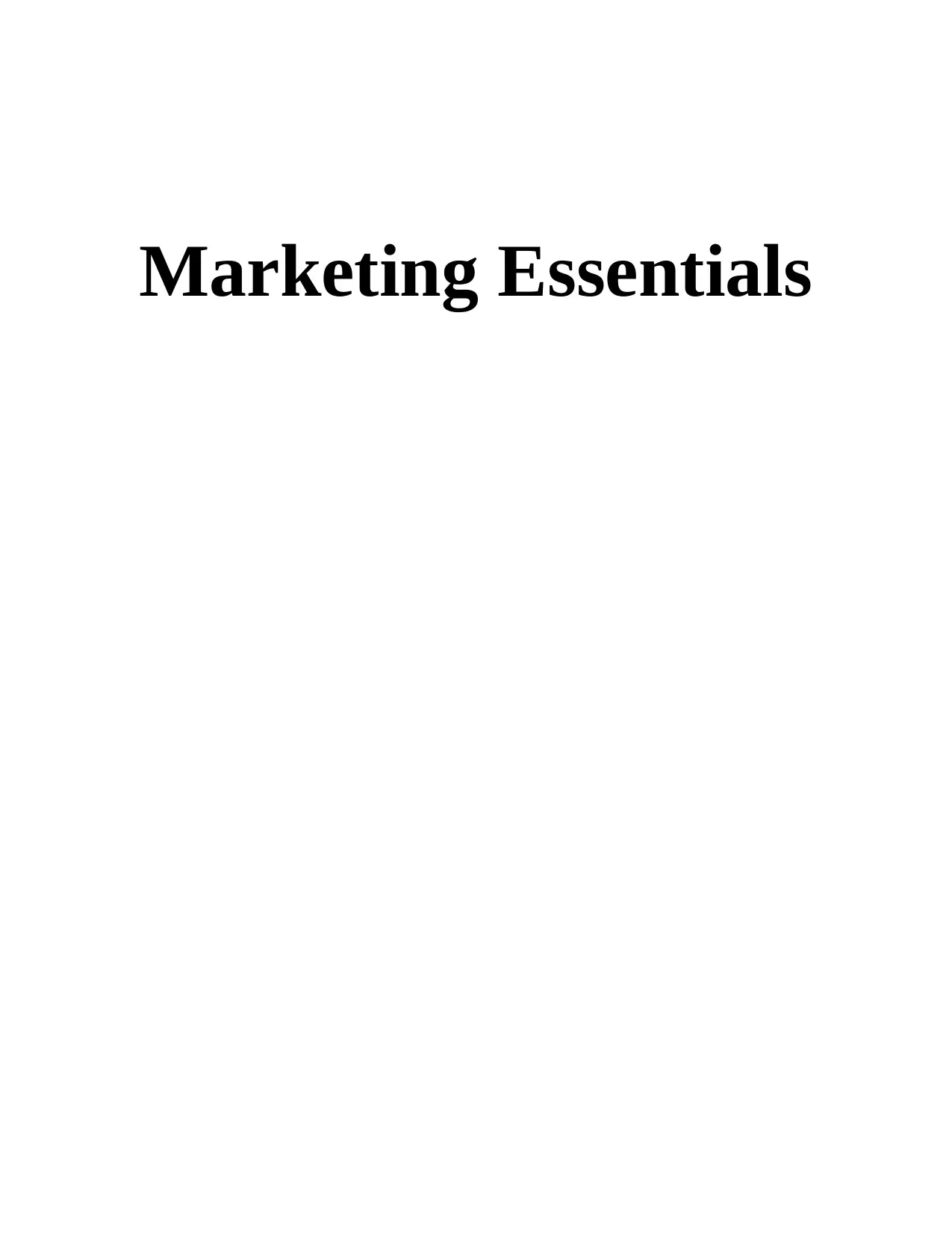
Marketing Essentials
Paraphrase This Document
Need a fresh take? Get an instant paraphrase of this document with our AI Paraphraser
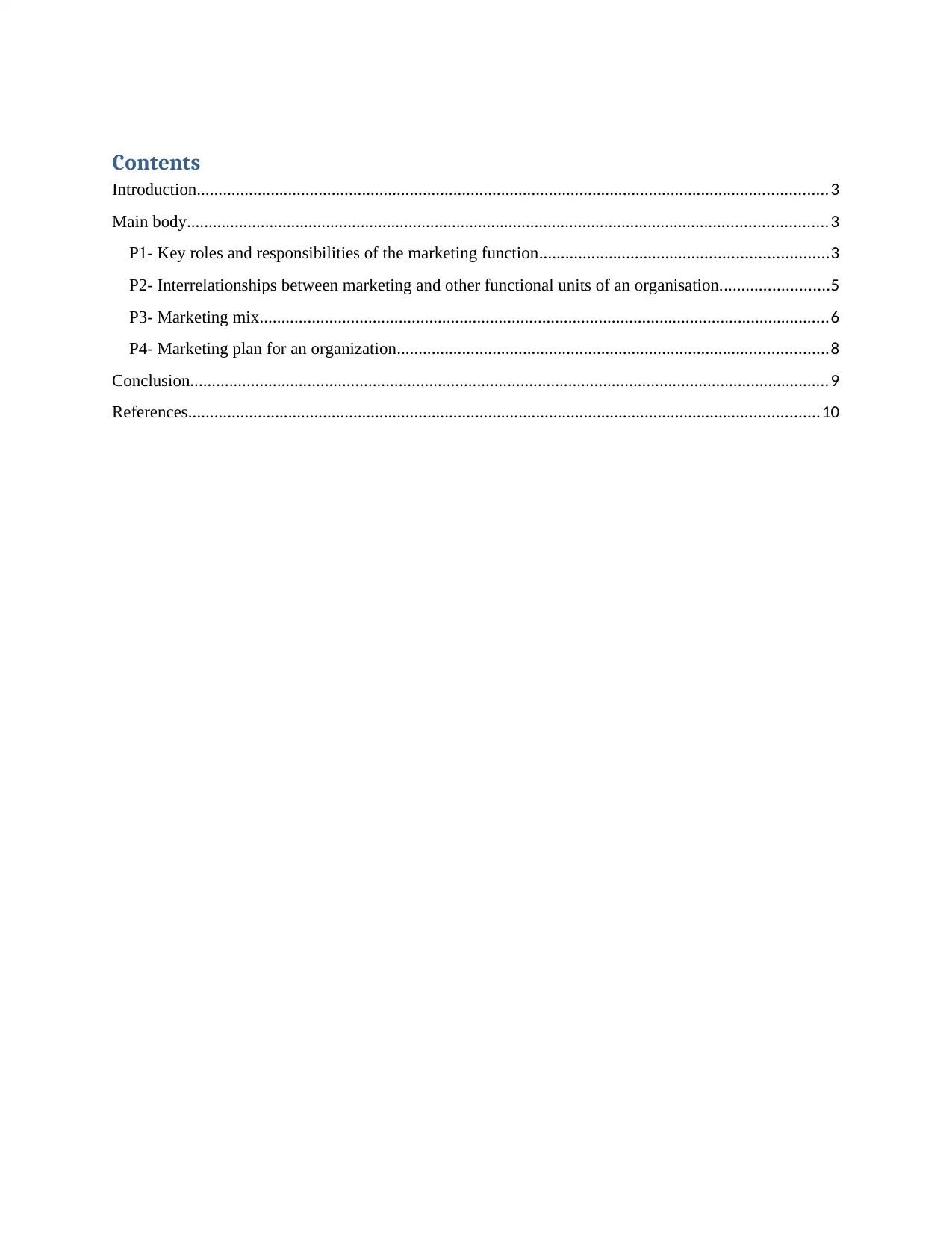
Contents
Introduction.................................................................................................................................................3
Main body...................................................................................................................................................3
P1- Key roles and responsibilities of the marketing function..................................................................3
P2- Interrelationships between marketing and other functional units of an organisation.........................5
P3- Marketing mix...................................................................................................................................6
P4- Marketing plan for an organization...................................................................................................8
Conclusion...................................................................................................................................................9
References.................................................................................................................................................10
Introduction.................................................................................................................................................3
Main body...................................................................................................................................................3
P1- Key roles and responsibilities of the marketing function..................................................................3
P2- Interrelationships between marketing and other functional units of an organisation.........................5
P3- Marketing mix...................................................................................................................................6
P4- Marketing plan for an organization...................................................................................................8
Conclusion...................................................................................................................................................9
References.................................................................................................................................................10
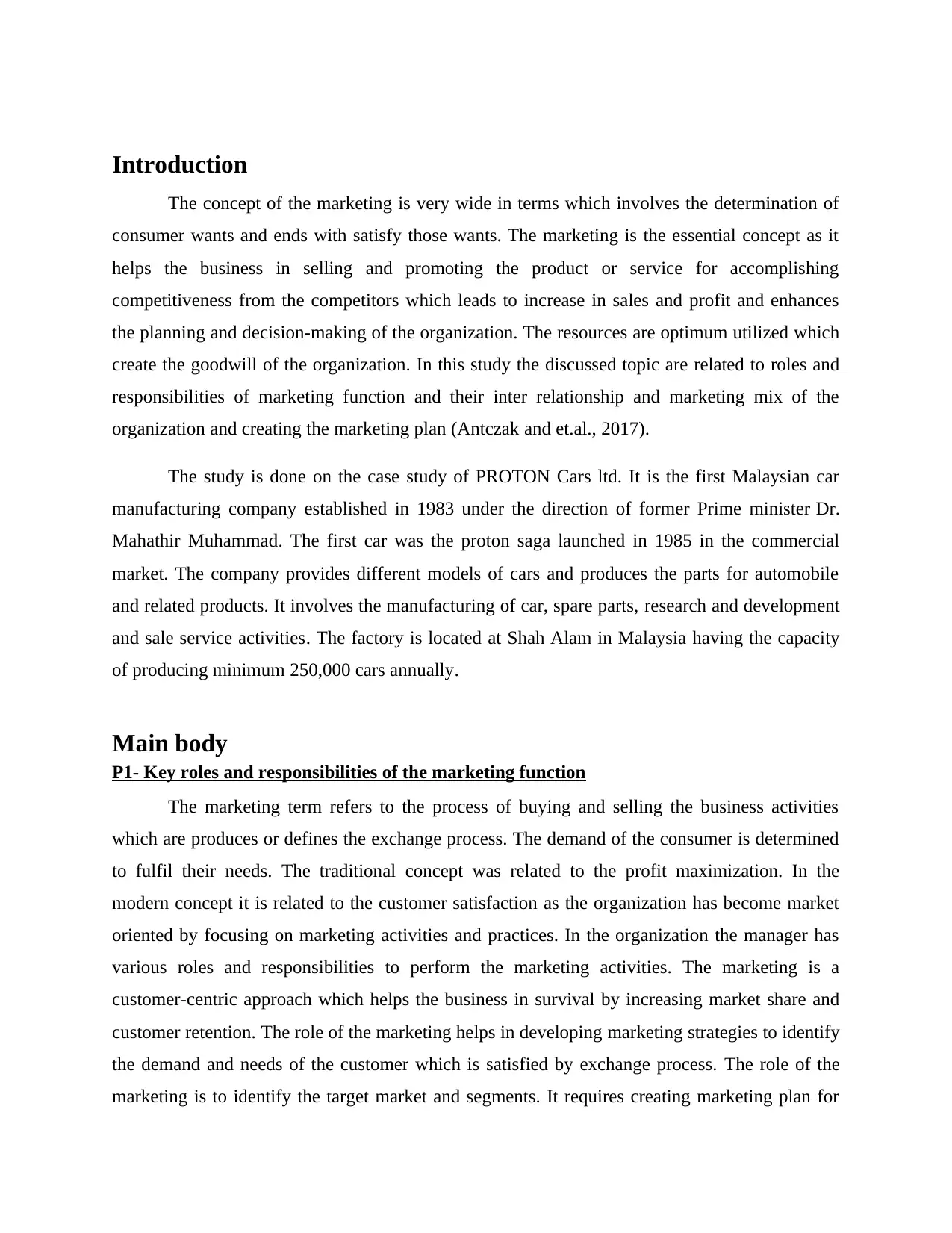
Introduction
The concept of the marketing is very wide in terms which involves the determination of
consumer wants and ends with satisfy those wants. The marketing is the essential concept as it
helps the business in selling and promoting the product or service for accomplishing
competitiveness from the competitors which leads to increase in sales and profit and enhances
the planning and decision-making of the organization. The resources are optimum utilized which
create the goodwill of the organization. In this study the discussed topic are related to roles and
responsibilities of marketing function and their inter relationship and marketing mix of the
organization and creating the marketing plan (Antczak and et.al., 2017).
The study is done on the case study of PROTON Cars ltd. It is the first Malaysian car
manufacturing company established in 1983 under the direction of former Prime minister Dr.
Mahathir Muhammad. The first car was the proton saga launched in 1985 in the commercial
market. The company provides different models of cars and produces the parts for automobile
and related products. It involves the manufacturing of car, spare parts, research and development
and sale service activities. The factory is located at Shah Alam in Malaysia having the capacity
of producing minimum 250,000 cars annually.
Main body
P1- Key roles and responsibilities of the marketing function
The marketing term refers to the process of buying and selling the business activities
which are produces or defines the exchange process. The demand of the consumer is determined
to fulfil their needs. The traditional concept was related to the profit maximization. In the
modern concept it is related to the customer satisfaction as the organization has become market
oriented by focusing on marketing activities and practices. In the organization the manager has
various roles and responsibilities to perform the marketing activities. The marketing is a
customer-centric approach which helps the business in survival by increasing market share and
customer retention. The role of the marketing helps in developing marketing strategies to identify
the demand and needs of the customer which is satisfied by exchange process. The role of the
marketing is to identify the target market and segments. It requires creating marketing plan for
The concept of the marketing is very wide in terms which involves the determination of
consumer wants and ends with satisfy those wants. The marketing is the essential concept as it
helps the business in selling and promoting the product or service for accomplishing
competitiveness from the competitors which leads to increase in sales and profit and enhances
the planning and decision-making of the organization. The resources are optimum utilized which
create the goodwill of the organization. In this study the discussed topic are related to roles and
responsibilities of marketing function and their inter relationship and marketing mix of the
organization and creating the marketing plan (Antczak and et.al., 2017).
The study is done on the case study of PROTON Cars ltd. It is the first Malaysian car
manufacturing company established in 1983 under the direction of former Prime minister Dr.
Mahathir Muhammad. The first car was the proton saga launched in 1985 in the commercial
market. The company provides different models of cars and produces the parts for automobile
and related products. It involves the manufacturing of car, spare parts, research and development
and sale service activities. The factory is located at Shah Alam in Malaysia having the capacity
of producing minimum 250,000 cars annually.
Main body
P1- Key roles and responsibilities of the marketing function
The marketing term refers to the process of buying and selling the business activities
which are produces or defines the exchange process. The demand of the consumer is determined
to fulfil their needs. The traditional concept was related to the profit maximization. In the
modern concept it is related to the customer satisfaction as the organization has become market
oriented by focusing on marketing activities and practices. In the organization the manager has
various roles and responsibilities to perform the marketing activities. The marketing is a
customer-centric approach which helps the business in survival by increasing market share and
customer retention. The role of the marketing helps in developing marketing strategies to identify
the demand and needs of the customer which is satisfied by exchange process. The role of the
marketing is to identify the target market and segments. It requires creating marketing plan for
⊘ This is a preview!⊘
Do you want full access?
Subscribe today to unlock all pages.

Trusted by 1+ million students worldwide
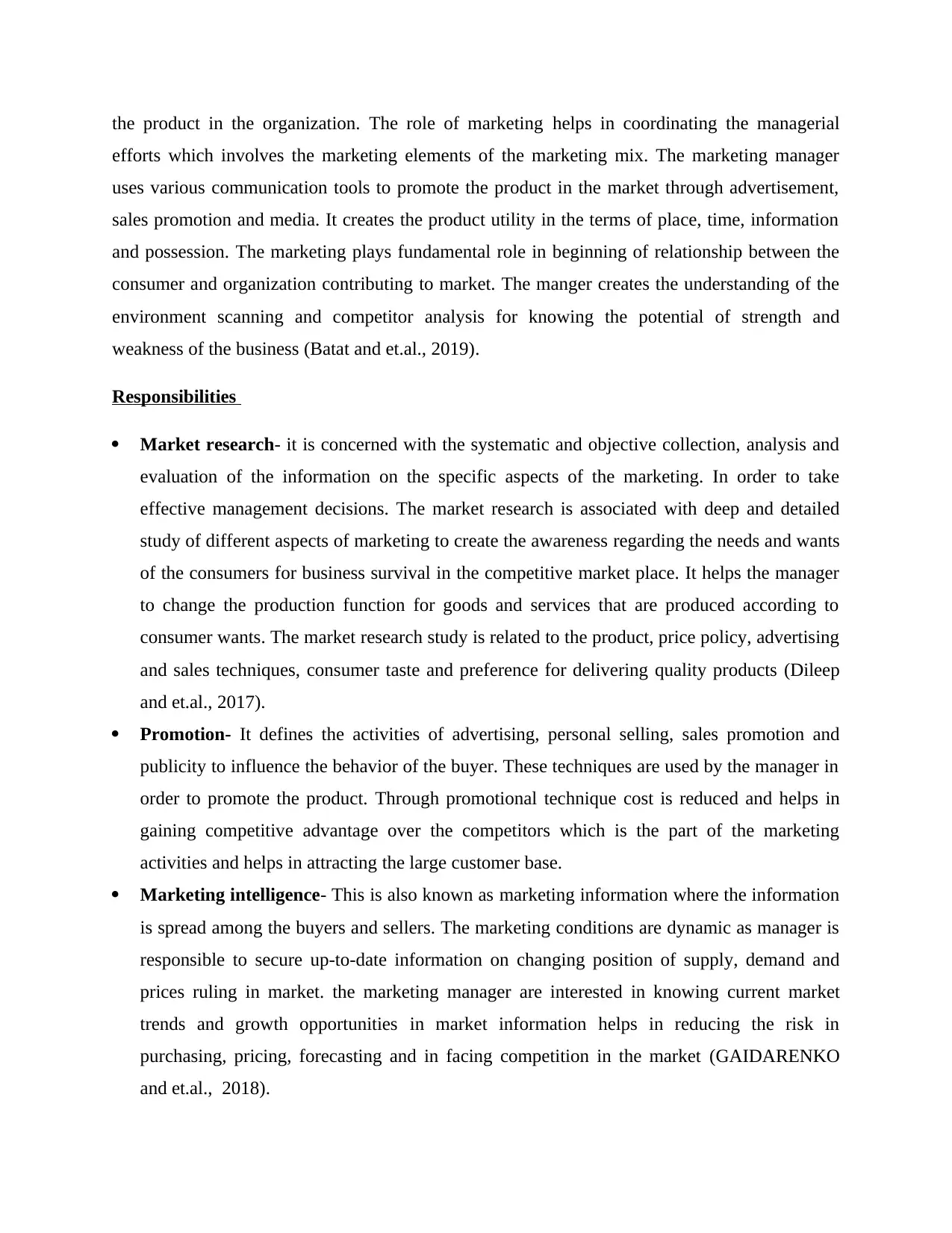
the product in the organization. The role of marketing helps in coordinating the managerial
efforts which involves the marketing elements of the marketing mix. The marketing manager
uses various communication tools to promote the product in the market through advertisement,
sales promotion and media. It creates the product utility in the terms of place, time, information
and possession. The marketing plays fundamental role in beginning of relationship between the
consumer and organization contributing to market. The manger creates the understanding of the
environment scanning and competitor analysis for knowing the potential of strength and
weakness of the business (Batat and et.al., 2019).
Responsibilities
Market research- it is concerned with the systematic and objective collection, analysis and
evaluation of the information on the specific aspects of the marketing. In order to take
effective management decisions. The market research is associated with deep and detailed
study of different aspects of marketing to create the awareness regarding the needs and wants
of the consumers for business survival in the competitive market place. It helps the manager
to change the production function for goods and services that are produced according to
consumer wants. The market research study is related to the product, price policy, advertising
and sales techniques, consumer taste and preference for delivering quality products (Dileep
and et.al., 2017).
Promotion- It defines the activities of advertising, personal selling, sales promotion and
publicity to influence the behavior of the buyer. These techniques are used by the manager in
order to promote the product. Through promotional technique cost is reduced and helps in
gaining competitive advantage over the competitors which is the part of the marketing
activities and helps in attracting the large customer base.
Marketing intelligence- This is also known as marketing information where the information
is spread among the buyers and sellers. The marketing conditions are dynamic as manager is
responsible to secure up-to-date information on changing position of supply, demand and
prices ruling in market. the marketing manager are interested in knowing current market
trends and growth opportunities in market information helps in reducing the risk in
purchasing, pricing, forecasting and in facing competition in the market (GAIDARENKO
and et.al., 2018).
efforts which involves the marketing elements of the marketing mix. The marketing manager
uses various communication tools to promote the product in the market through advertisement,
sales promotion and media. It creates the product utility in the terms of place, time, information
and possession. The marketing plays fundamental role in beginning of relationship between the
consumer and organization contributing to market. The manger creates the understanding of the
environment scanning and competitor analysis for knowing the potential of strength and
weakness of the business (Batat and et.al., 2019).
Responsibilities
Market research- it is concerned with the systematic and objective collection, analysis and
evaluation of the information on the specific aspects of the marketing. In order to take
effective management decisions. The market research is associated with deep and detailed
study of different aspects of marketing to create the awareness regarding the needs and wants
of the consumers for business survival in the competitive market place. It helps the manager
to change the production function for goods and services that are produced according to
consumer wants. The market research study is related to the product, price policy, advertising
and sales techniques, consumer taste and preference for delivering quality products (Dileep
and et.al., 2017).
Promotion- It defines the activities of advertising, personal selling, sales promotion and
publicity to influence the behavior of the buyer. These techniques are used by the manager in
order to promote the product. Through promotional technique cost is reduced and helps in
gaining competitive advantage over the competitors which is the part of the marketing
activities and helps in attracting the large customer base.
Marketing intelligence- This is also known as marketing information where the information
is spread among the buyers and sellers. The marketing conditions are dynamic as manager is
responsible to secure up-to-date information on changing position of supply, demand and
prices ruling in market. the marketing manager are interested in knowing current market
trends and growth opportunities in market information helps in reducing the risk in
purchasing, pricing, forecasting and in facing competition in the market (GAIDARENKO
and et.al., 2018).
Paraphrase This Document
Need a fresh take? Get an instant paraphrase of this document with our AI Paraphraser
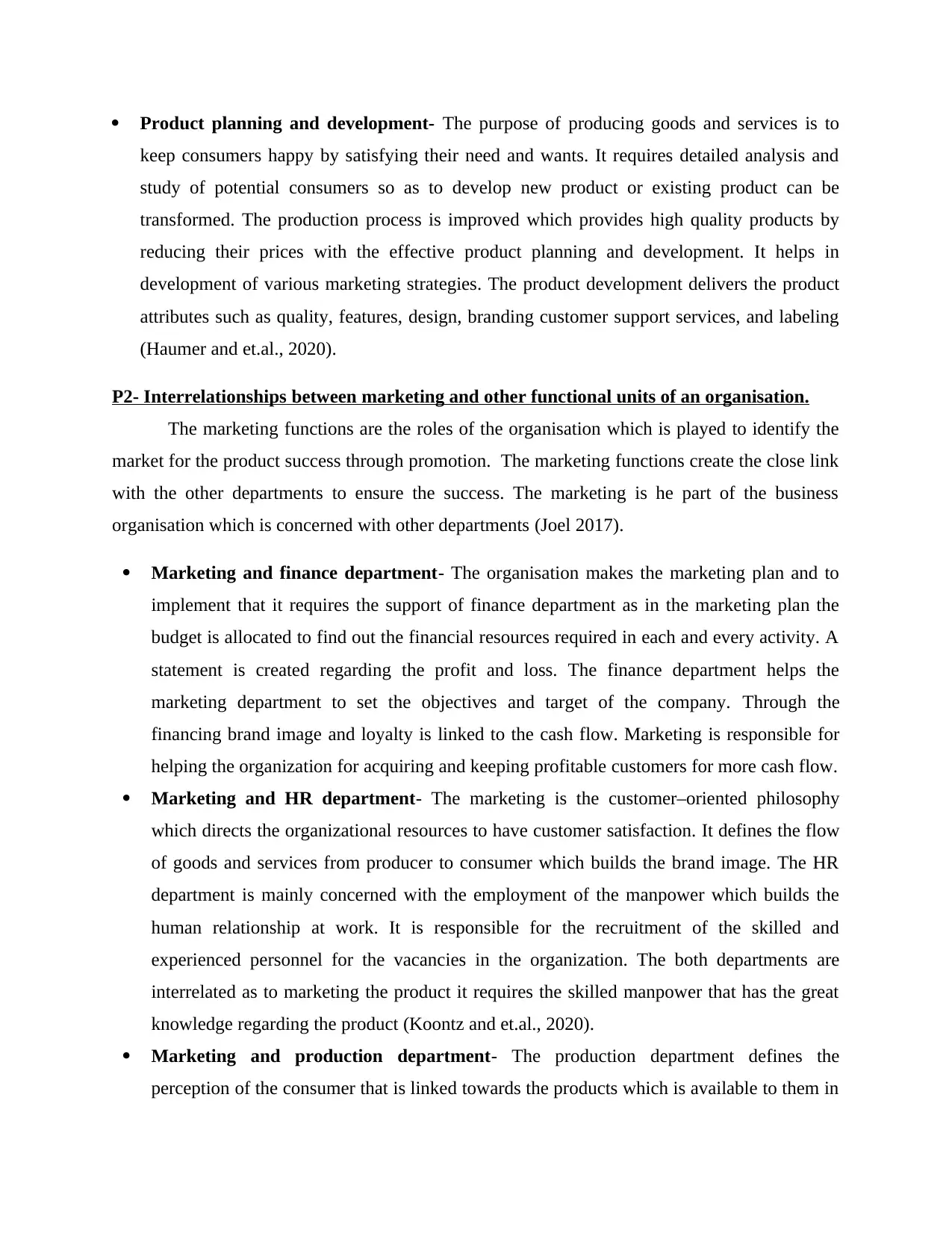
Product planning and development- The purpose of producing goods and services is to
keep consumers happy by satisfying their need and wants. It requires detailed analysis and
study of potential consumers so as to develop new product or existing product can be
transformed. The production process is improved which provides high quality products by
reducing their prices with the effective product planning and development. It helps in
development of various marketing strategies. The product development delivers the product
attributes such as quality, features, design, branding customer support services, and labeling
(Haumer and et.al., 2020).
P2- Interrelationships between marketing and other functional units of an organisation.
The marketing functions are the roles of the organisation which is played to identify the
market for the product success through promotion. The marketing functions create the close link
with the other departments to ensure the success. The marketing is he part of the business
organisation which is concerned with other departments (Joel 2017).
Marketing and finance department- The organisation makes the marketing plan and to
implement that it requires the support of finance department as in the marketing plan the
budget is allocated to find out the financial resources required in each and every activity. A
statement is created regarding the profit and loss. The finance department helps the
marketing department to set the objectives and target of the company. Through the
financing brand image and loyalty is linked to the cash flow. Marketing is responsible for
helping the organization for acquiring and keeping profitable customers for more cash flow.
Marketing and HR department- The marketing is the customer–oriented philosophy
which directs the organizational resources to have customer satisfaction. It defines the flow
of goods and services from producer to consumer which builds the brand image. The HR
department is mainly concerned with the employment of the manpower which builds the
human relationship at work. It is responsible for the recruitment of the skilled and
experienced personnel for the vacancies in the organization. The both departments are
interrelated as to marketing the product it requires the skilled manpower that has the great
knowledge regarding the product (Koontz and et.al., 2020).
Marketing and production department- The production department defines the
perception of the consumer that is linked towards the products which is available to them in
keep consumers happy by satisfying their need and wants. It requires detailed analysis and
study of potential consumers so as to develop new product or existing product can be
transformed. The production process is improved which provides high quality products by
reducing their prices with the effective product planning and development. It helps in
development of various marketing strategies. The product development delivers the product
attributes such as quality, features, design, branding customer support services, and labeling
(Haumer and et.al., 2020).
P2- Interrelationships between marketing and other functional units of an organisation.
The marketing functions are the roles of the organisation which is played to identify the
market for the product success through promotion. The marketing functions create the close link
with the other departments to ensure the success. The marketing is he part of the business
organisation which is concerned with other departments (Joel 2017).
Marketing and finance department- The organisation makes the marketing plan and to
implement that it requires the support of finance department as in the marketing plan the
budget is allocated to find out the financial resources required in each and every activity. A
statement is created regarding the profit and loss. The finance department helps the
marketing department to set the objectives and target of the company. Through the
financing brand image and loyalty is linked to the cash flow. Marketing is responsible for
helping the organization for acquiring and keeping profitable customers for more cash flow.
Marketing and HR department- The marketing is the customer–oriented philosophy
which directs the organizational resources to have customer satisfaction. It defines the flow
of goods and services from producer to consumer which builds the brand image. The HR
department is mainly concerned with the employment of the manpower which builds the
human relationship at work. It is responsible for the recruitment of the skilled and
experienced personnel for the vacancies in the organization. The both departments are
interrelated as to marketing the product it requires the skilled manpower that has the great
knowledge regarding the product (Koontz and et.al., 2020).
Marketing and production department- The production department defines the
perception of the consumer that is linked towards the products which is available to them in
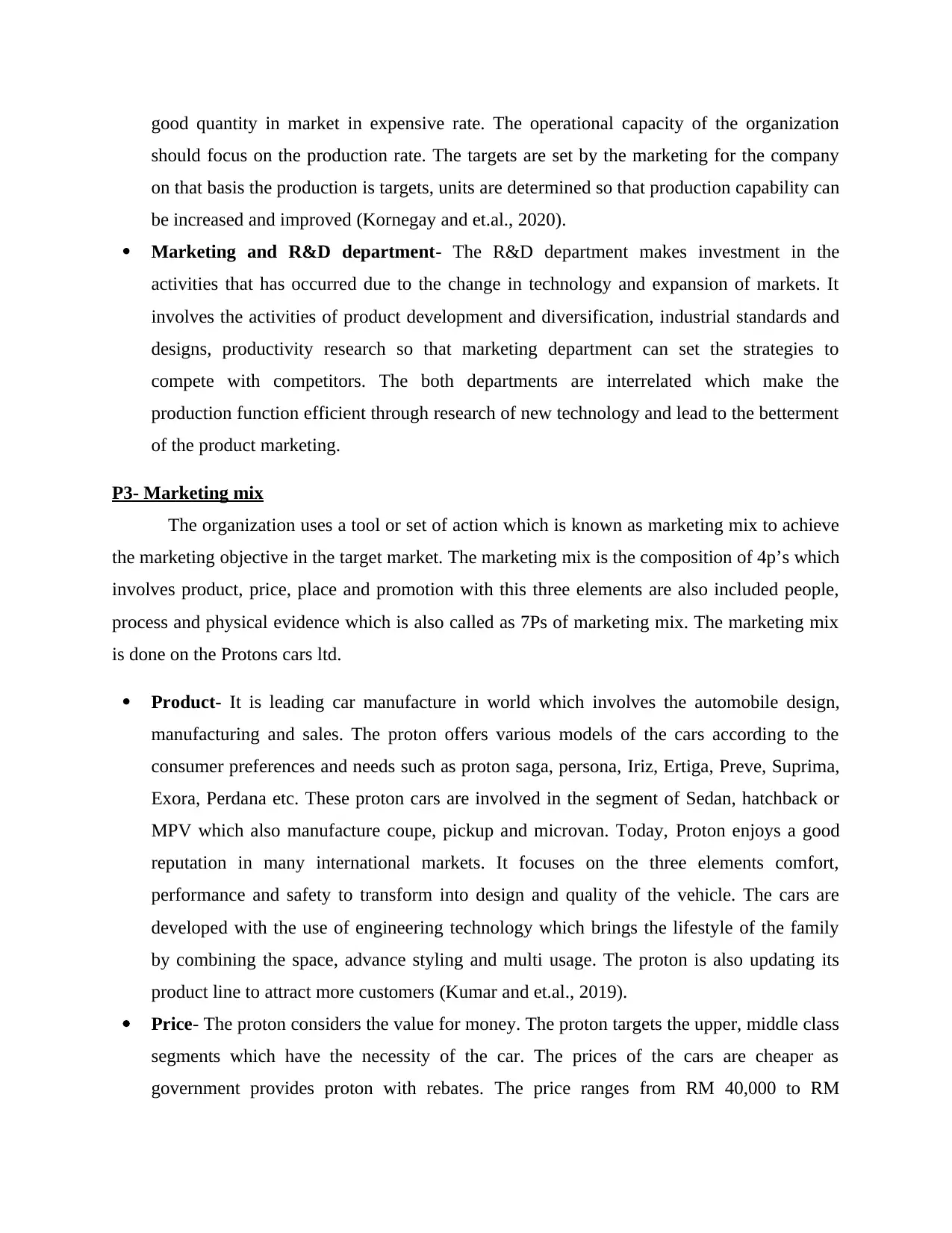
good quantity in market in expensive rate. The operational capacity of the organization
should focus on the production rate. The targets are set by the marketing for the company
on that basis the production is targets, units are determined so that production capability can
be increased and improved (Kornegay and et.al., 2020).
Marketing and R&D department- The R&D department makes investment in the
activities that has occurred due to the change in technology and expansion of markets. It
involves the activities of product development and diversification, industrial standards and
designs, productivity research so that marketing department can set the strategies to
compete with competitors. The both departments are interrelated which make the
production function efficient through research of new technology and lead to the betterment
of the product marketing.
P3- Marketing mix
The organization uses a tool or set of action which is known as marketing mix to achieve
the marketing objective in the target market. The marketing mix is the composition of 4p’s which
involves product, price, place and promotion with this three elements are also included people,
process and physical evidence which is also called as 7Ps of marketing mix. The marketing mix
is done on the Protons cars ltd.
Product- It is leading car manufacture in world which involves the automobile design,
manufacturing and sales. The proton offers various models of the cars according to the
consumer preferences and needs such as proton saga, persona, Iriz, Ertiga, Preve, Suprima,
Exora, Perdana etc. These proton cars are involved in the segment of Sedan, hatchback or
MPV which also manufacture coupe, pickup and microvan. Today, Proton enjoys a good
reputation in many international markets. It focuses on the three elements comfort,
performance and safety to transform into design and quality of the vehicle. The cars are
developed with the use of engineering technology which brings the lifestyle of the family
by combining the space, advance styling and multi usage. The proton is also updating its
product line to attract more customers (Kumar and et.al., 2019).
Price- The proton considers the value for money. The proton targets the upper, middle class
segments which have the necessity of the car. The prices of the cars are cheaper as
government provides proton with rebates. The price ranges from RM 40,000 to RM
should focus on the production rate. The targets are set by the marketing for the company
on that basis the production is targets, units are determined so that production capability can
be increased and improved (Kornegay and et.al., 2020).
Marketing and R&D department- The R&D department makes investment in the
activities that has occurred due to the change in technology and expansion of markets. It
involves the activities of product development and diversification, industrial standards and
designs, productivity research so that marketing department can set the strategies to
compete with competitors. The both departments are interrelated which make the
production function efficient through research of new technology and lead to the betterment
of the product marketing.
P3- Marketing mix
The organization uses a tool or set of action which is known as marketing mix to achieve
the marketing objective in the target market. The marketing mix is the composition of 4p’s which
involves product, price, place and promotion with this three elements are also included people,
process and physical evidence which is also called as 7Ps of marketing mix. The marketing mix
is done on the Protons cars ltd.
Product- It is leading car manufacture in world which involves the automobile design,
manufacturing and sales. The proton offers various models of the cars according to the
consumer preferences and needs such as proton saga, persona, Iriz, Ertiga, Preve, Suprima,
Exora, Perdana etc. These proton cars are involved in the segment of Sedan, hatchback or
MPV which also manufacture coupe, pickup and microvan. Today, Proton enjoys a good
reputation in many international markets. It focuses on the three elements comfort,
performance and safety to transform into design and quality of the vehicle. The cars are
developed with the use of engineering technology which brings the lifestyle of the family
by combining the space, advance styling and multi usage. The proton is also updating its
product line to attract more customers (Kumar and et.al., 2019).
Price- The proton considers the value for money. The proton targets the upper, middle class
segments which have the necessity of the car. The prices of the cars are cheaper as
government provides proton with rebates. The price ranges from RM 40,000 to RM
⊘ This is a preview!⊘
Do you want full access?
Subscribe today to unlock all pages.

Trusted by 1+ million students worldwide
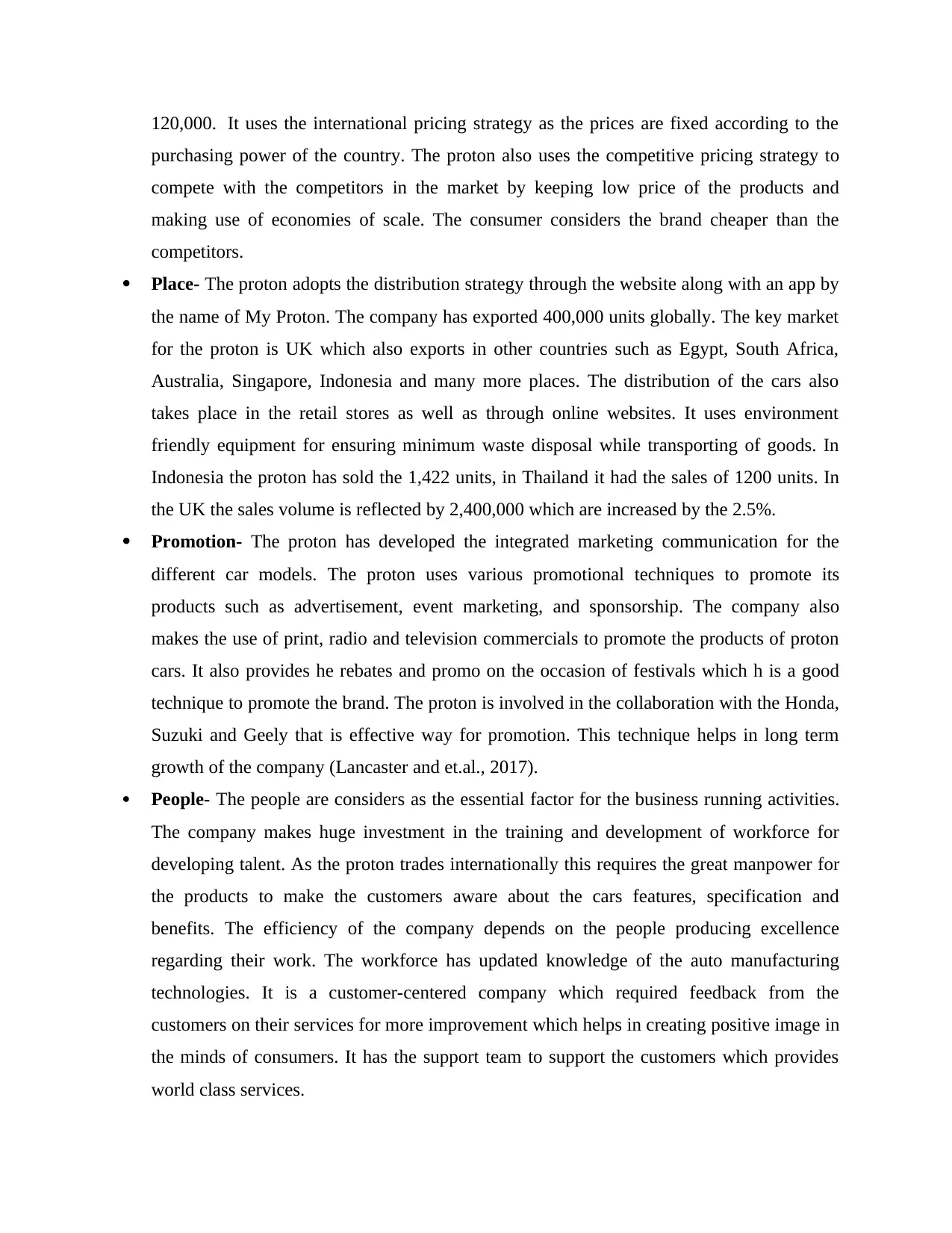
120,000. It uses the international pricing strategy as the prices are fixed according to the
purchasing power of the country. The proton also uses the competitive pricing strategy to
compete with the competitors in the market by keeping low price of the products and
making use of economies of scale. The consumer considers the brand cheaper than the
competitors.
Place- The proton adopts the distribution strategy through the website along with an app by
the name of My Proton. The company has exported 400,000 units globally. The key market
for the proton is UK which also exports in other countries such as Egypt, South Africa,
Australia, Singapore, Indonesia and many more places. The distribution of the cars also
takes place in the retail stores as well as through online websites. It uses environment
friendly equipment for ensuring minimum waste disposal while transporting of goods. In
Indonesia the proton has sold the 1,422 units, in Thailand it had the sales of 1200 units. In
the UK the sales volume is reflected by 2,400,000 which are increased by the 2.5%.
Promotion- The proton has developed the integrated marketing communication for the
different car models. The proton uses various promotional techniques to promote its
products such as advertisement, event marketing, and sponsorship. The company also
makes the use of print, radio and television commercials to promote the products of proton
cars. It also provides he rebates and promo on the occasion of festivals which h is a good
technique to promote the brand. The proton is involved in the collaboration with the Honda,
Suzuki and Geely that is effective way for promotion. This technique helps in long term
growth of the company (Lancaster and et.al., 2017).
People- The people are considers as the essential factor for the business running activities.
The company makes huge investment in the training and development of workforce for
developing talent. As the proton trades internationally this requires the great manpower for
the products to make the customers aware about the cars features, specification and
benefits. The efficiency of the company depends on the people producing excellence
regarding their work. The workforce has updated knowledge of the auto manufacturing
technologies. It is a customer-centered company which required feedback from the
customers on their services for more improvement which helps in creating positive image in
the minds of consumers. It has the support team to support the customers which provides
world class services.
purchasing power of the country. The proton also uses the competitive pricing strategy to
compete with the competitors in the market by keeping low price of the products and
making use of economies of scale. The consumer considers the brand cheaper than the
competitors.
Place- The proton adopts the distribution strategy through the website along with an app by
the name of My Proton. The company has exported 400,000 units globally. The key market
for the proton is UK which also exports in other countries such as Egypt, South Africa,
Australia, Singapore, Indonesia and many more places. The distribution of the cars also
takes place in the retail stores as well as through online websites. It uses environment
friendly equipment for ensuring minimum waste disposal while transporting of goods. In
Indonesia the proton has sold the 1,422 units, in Thailand it had the sales of 1200 units. In
the UK the sales volume is reflected by 2,400,000 which are increased by the 2.5%.
Promotion- The proton has developed the integrated marketing communication for the
different car models. The proton uses various promotional techniques to promote its
products such as advertisement, event marketing, and sponsorship. The company also
makes the use of print, radio and television commercials to promote the products of proton
cars. It also provides he rebates and promo on the occasion of festivals which h is a good
technique to promote the brand. The proton is involved in the collaboration with the Honda,
Suzuki and Geely that is effective way for promotion. This technique helps in long term
growth of the company (Lancaster and et.al., 2017).
People- The people are considers as the essential factor for the business running activities.
The company makes huge investment in the training and development of workforce for
developing talent. As the proton trades internationally this requires the great manpower for
the products to make the customers aware about the cars features, specification and
benefits. The efficiency of the company depends on the people producing excellence
regarding their work. The workforce has updated knowledge of the auto manufacturing
technologies. It is a customer-centered company which required feedback from the
customers on their services for more improvement which helps in creating positive image in
the minds of consumers. It has the support team to support the customers which provides
world class services.
Paraphrase This Document
Need a fresh take? Get an instant paraphrase of this document with our AI Paraphraser
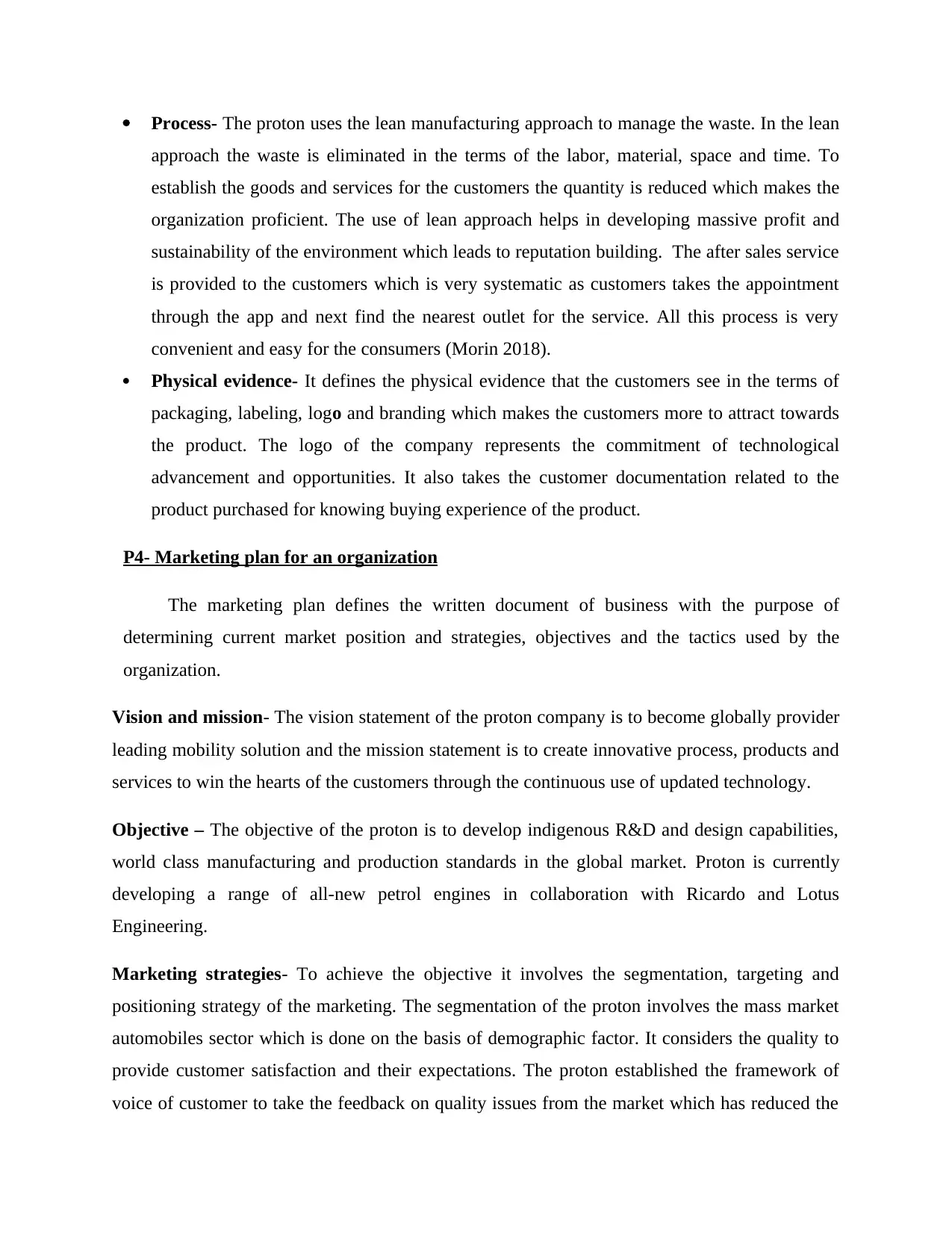
Process- The proton uses the lean manufacturing approach to manage the waste. In the lean
approach the waste is eliminated in the terms of the labor, material, space and time. To
establish the goods and services for the customers the quantity is reduced which makes the
organization proficient. The use of lean approach helps in developing massive profit and
sustainability of the environment which leads to reputation building. The after sales service
is provided to the customers which is very systematic as customers takes the appointment
through the app and next find the nearest outlet for the service. All this process is very
convenient and easy for the consumers (Morin 2018).
Physical evidence- It defines the physical evidence that the customers see in the terms of
packaging, labeling, logo and branding which makes the customers more to attract towards
the product. The logo of the company represents the commitment of technological
advancement and opportunities. It also takes the customer documentation related to the
product purchased for knowing buying experience of the product.
P4- Marketing plan for an organization
The marketing plan defines the written document of business with the purpose of
determining current market position and strategies, objectives and the tactics used by the
organization.
Vision and mission- The vision statement of the proton company is to become globally provider
leading mobility solution and the mission statement is to create innovative process, products and
services to win the hearts of the customers through the continuous use of updated technology.
Objective – The objective of the proton is to develop indigenous R&D and design capabilities,
world class manufacturing and production standards in the global market. Proton is currently
developing a range of all-new petrol engines in collaboration with Ricardo and Lotus
Engineering.
Marketing strategies- To achieve the objective it involves the segmentation, targeting and
positioning strategy of the marketing. The segmentation of the proton involves the mass market
automobiles sector which is done on the basis of demographic factor. It considers the quality to
provide customer satisfaction and their expectations. The proton established the framework of
voice of customer to take the feedback on quality issues from the market which has reduced the
approach the waste is eliminated in the terms of the labor, material, space and time. To
establish the goods and services for the customers the quantity is reduced which makes the
organization proficient. The use of lean approach helps in developing massive profit and
sustainability of the environment which leads to reputation building. The after sales service
is provided to the customers which is very systematic as customers takes the appointment
through the app and next find the nearest outlet for the service. All this process is very
convenient and easy for the consumers (Morin 2018).
Physical evidence- It defines the physical evidence that the customers see in the terms of
packaging, labeling, logo and branding which makes the customers more to attract towards
the product. The logo of the company represents the commitment of technological
advancement and opportunities. It also takes the customer documentation related to the
product purchased for knowing buying experience of the product.
P4- Marketing plan for an organization
The marketing plan defines the written document of business with the purpose of
determining current market position and strategies, objectives and the tactics used by the
organization.
Vision and mission- The vision statement of the proton company is to become globally provider
leading mobility solution and the mission statement is to create innovative process, products and
services to win the hearts of the customers through the continuous use of updated technology.
Objective – The objective of the proton is to develop indigenous R&D and design capabilities,
world class manufacturing and production standards in the global market. Proton is currently
developing a range of all-new petrol engines in collaboration with Ricardo and Lotus
Engineering.
Marketing strategies- To achieve the objective it involves the segmentation, targeting and
positioning strategy of the marketing. The segmentation of the proton involves the mass market
automobiles sector which is done on the basis of demographic factor. It considers the quality to
provide customer satisfaction and their expectations. The proton established the framework of
voice of customer to take the feedback on quality issues from the market which has reduced the
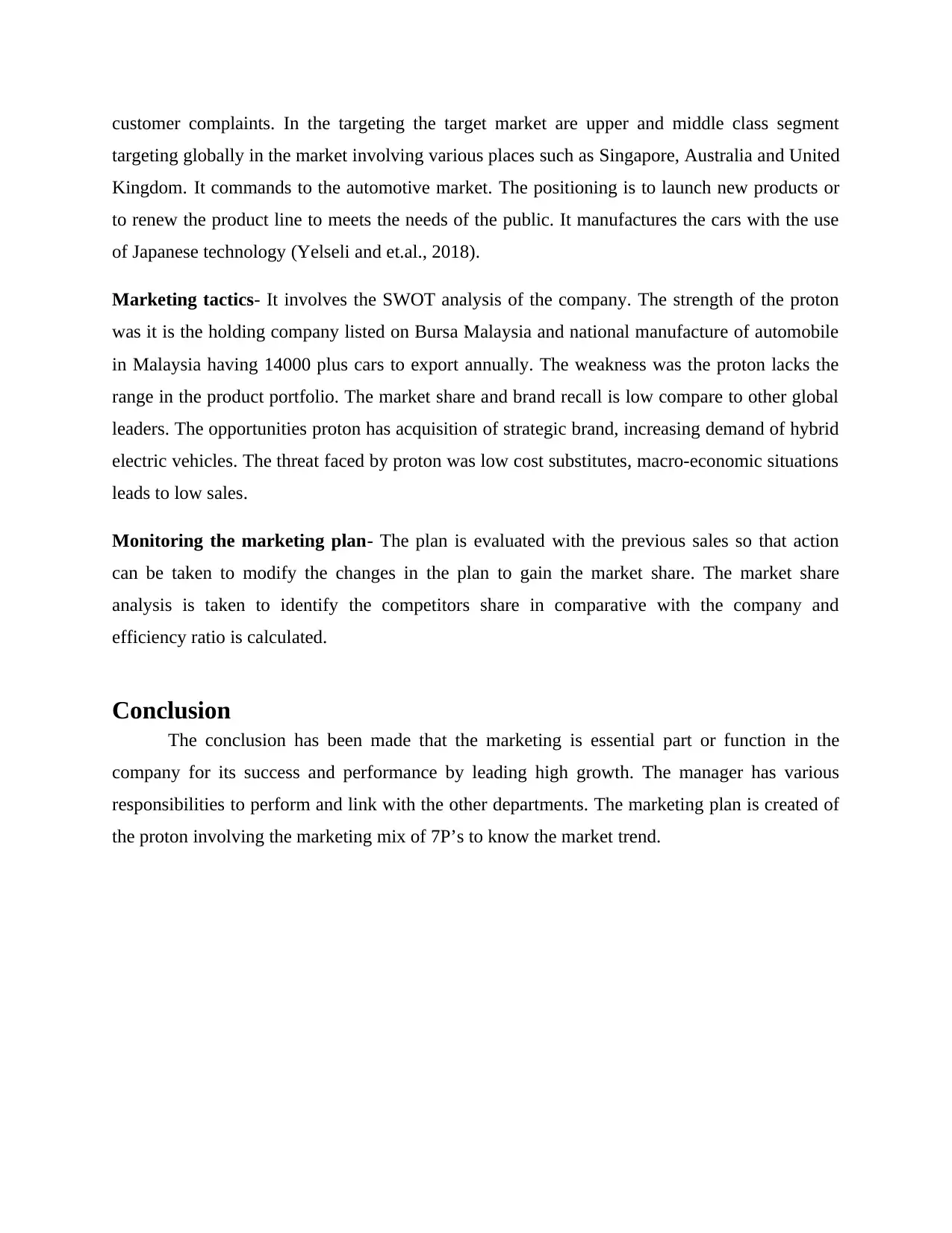
customer complaints. In the targeting the target market are upper and middle class segment
targeting globally in the market involving various places such as Singapore, Australia and United
Kingdom. It commands to the automotive market. The positioning is to launch new products or
to renew the product line to meets the needs of the public. It manufactures the cars with the use
of Japanese technology (Yelseli and et.al., 2018).
Marketing tactics- It involves the SWOT analysis of the company. The strength of the proton
was it is the holding company listed on Bursa Malaysia and national manufacture of automobile
in Malaysia having 14000 plus cars to export annually. The weakness was the proton lacks the
range in the product portfolio. The market share and brand recall is low compare to other global
leaders. The opportunities proton has acquisition of strategic brand, increasing demand of hybrid
electric vehicles. The threat faced by proton was low cost substitutes, macro-economic situations
leads to low sales.
Monitoring the marketing plan- The plan is evaluated with the previous sales so that action
can be taken to modify the changes in the plan to gain the market share. The market share
analysis is taken to identify the competitors share in comparative with the company and
efficiency ratio is calculated.
Conclusion
The conclusion has been made that the marketing is essential part or function in the
company for its success and performance by leading high growth. The manager has various
responsibilities to perform and link with the other departments. The marketing plan is created of
the proton involving the marketing mix of 7P’s to know the market trend.
targeting globally in the market involving various places such as Singapore, Australia and United
Kingdom. It commands to the automotive market. The positioning is to launch new products or
to renew the product line to meets the needs of the public. It manufactures the cars with the use
of Japanese technology (Yelseli and et.al., 2018).
Marketing tactics- It involves the SWOT analysis of the company. The strength of the proton
was it is the holding company listed on Bursa Malaysia and national manufacture of automobile
in Malaysia having 14000 plus cars to export annually. The weakness was the proton lacks the
range in the product portfolio. The market share and brand recall is low compare to other global
leaders. The opportunities proton has acquisition of strategic brand, increasing demand of hybrid
electric vehicles. The threat faced by proton was low cost substitutes, macro-economic situations
leads to low sales.
Monitoring the marketing plan- The plan is evaluated with the previous sales so that action
can be taken to modify the changes in the plan to gain the market share. The market share
analysis is taken to identify the competitors share in comparative with the company and
efficiency ratio is calculated.
Conclusion
The conclusion has been made that the marketing is essential part or function in the
company for its success and performance by leading high growth. The manager has various
responsibilities to perform and link with the other departments. The marketing plan is created of
the proton involving the marketing mix of 7P’s to know the market trend.
⊘ This is a preview!⊘
Do you want full access?
Subscribe today to unlock all pages.

Trusted by 1+ million students worldwide
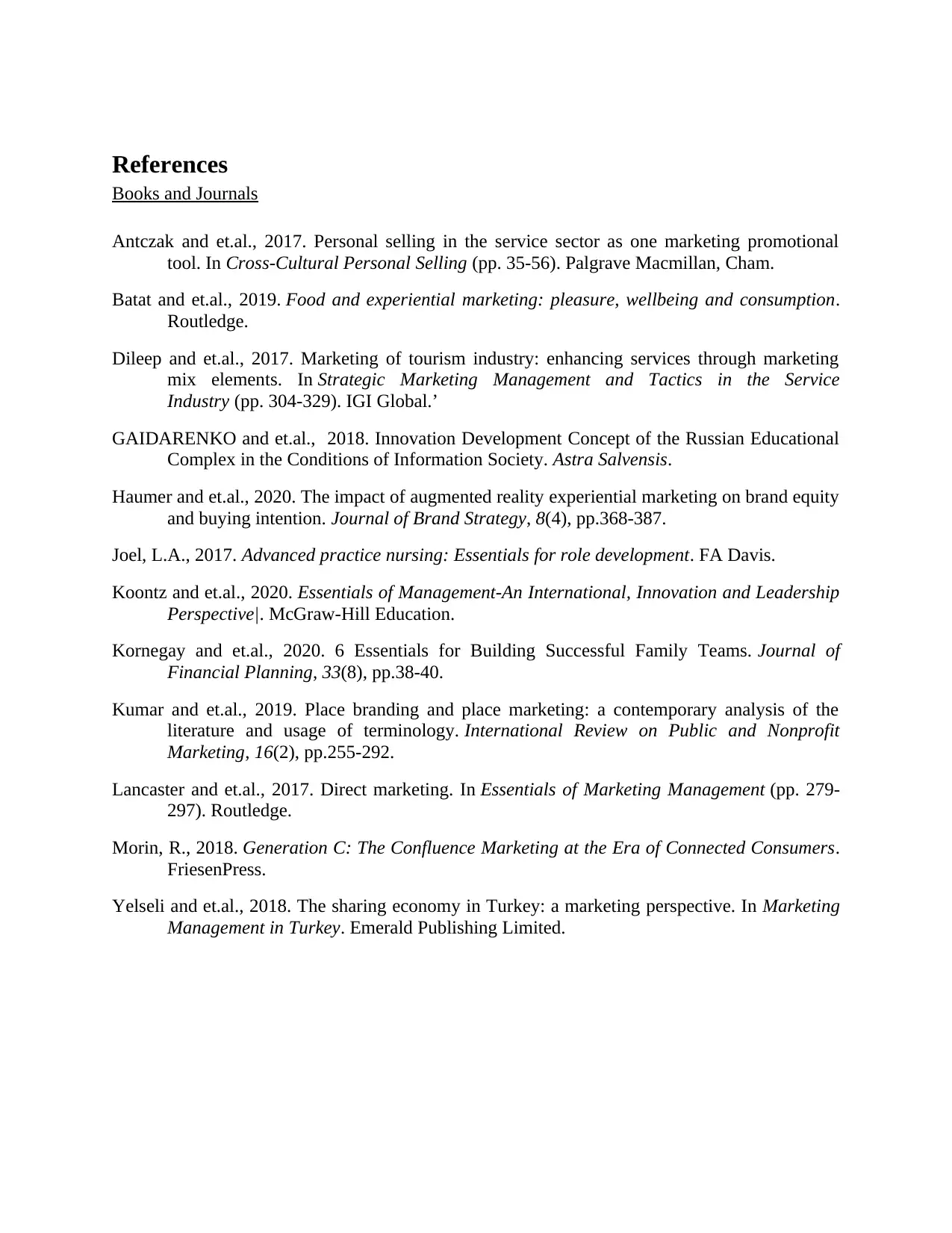
References
Books and Journals
Antczak and et.al., 2017. Personal selling in the service sector as one marketing promotional
tool. In Cross-Cultural Personal Selling (pp. 35-56). Palgrave Macmillan, Cham.
Batat and et.al., 2019. Food and experiential marketing: pleasure, wellbeing and consumption.
Routledge.
Dileep and et.al., 2017. Marketing of tourism industry: enhancing services through marketing
mix elements. In Strategic Marketing Management and Tactics in the Service
Industry (pp. 304-329). IGI Global.’
GAIDARENKO and et.al., 2018. Innovation Development Concept of the Russian Educational
Complex in the Conditions of Information Society. Astra Salvensis.
Haumer and et.al., 2020. The impact of augmented reality experiential marketing on brand equity
and buying intention. Journal of Brand Strategy, 8(4), pp.368-387.
Joel, L.A., 2017. Advanced practice nursing: Essentials for role development. FA Davis.
Koontz and et.al., 2020. Essentials of Management-An International, Innovation and Leadership
Perspective|. McGraw-Hill Education.
Kornegay and et.al., 2020. 6 Essentials for Building Successful Family Teams. Journal of
Financial Planning, 33(8), pp.38-40.
Kumar and et.al., 2019. Place branding and place marketing: a contemporary analysis of the
literature and usage of terminology. International Review on Public and Nonprofit
Marketing, 16(2), pp.255-292.
Lancaster and et.al., 2017. Direct marketing. In Essentials of Marketing Management (pp. 279-
297). Routledge.
Morin, R., 2018. Generation C: The Confluence Marketing at the Era of Connected Consumers.
FriesenPress.
Yelseli and et.al., 2018. The sharing economy in Turkey: a marketing perspective. In Marketing
Management in Turkey. Emerald Publishing Limited.
Books and Journals
Antczak and et.al., 2017. Personal selling in the service sector as one marketing promotional
tool. In Cross-Cultural Personal Selling (pp. 35-56). Palgrave Macmillan, Cham.
Batat and et.al., 2019. Food and experiential marketing: pleasure, wellbeing and consumption.
Routledge.
Dileep and et.al., 2017. Marketing of tourism industry: enhancing services through marketing
mix elements. In Strategic Marketing Management and Tactics in the Service
Industry (pp. 304-329). IGI Global.’
GAIDARENKO and et.al., 2018. Innovation Development Concept of the Russian Educational
Complex in the Conditions of Information Society. Astra Salvensis.
Haumer and et.al., 2020. The impact of augmented reality experiential marketing on brand equity
and buying intention. Journal of Brand Strategy, 8(4), pp.368-387.
Joel, L.A., 2017. Advanced practice nursing: Essentials for role development. FA Davis.
Koontz and et.al., 2020. Essentials of Management-An International, Innovation and Leadership
Perspective|. McGraw-Hill Education.
Kornegay and et.al., 2020. 6 Essentials for Building Successful Family Teams. Journal of
Financial Planning, 33(8), pp.38-40.
Kumar and et.al., 2019. Place branding and place marketing: a contemporary analysis of the
literature and usage of terminology. International Review on Public and Nonprofit
Marketing, 16(2), pp.255-292.
Lancaster and et.al., 2017. Direct marketing. In Essentials of Marketing Management (pp. 279-
297). Routledge.
Morin, R., 2018. Generation C: The Confluence Marketing at the Era of Connected Consumers.
FriesenPress.
Yelseli and et.al., 2018. The sharing economy in Turkey: a marketing perspective. In Marketing
Management in Turkey. Emerald Publishing Limited.
Paraphrase This Document
Need a fresh take? Get an instant paraphrase of this document with our AI Paraphraser

1 out of 11
Related Documents
Your All-in-One AI-Powered Toolkit for Academic Success.
+13062052269
info@desklib.com
Available 24*7 on WhatsApp / Email
![[object Object]](/_next/static/media/star-bottom.7253800d.svg)
Unlock your academic potential
Copyright © 2020–2025 A2Z Services. All Rights Reserved. Developed and managed by ZUCOL.





